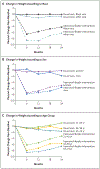Weight Loss in Underserved Patients - A Cluster-Randomized Trial
- PMID: 32877581
- PMCID: PMC7493523
- DOI: 10.1056/NEJMoa2007448
Weight Loss in Underserved Patients - A Cluster-Randomized Trial
Abstract
Background: Evidence of the effectiveness of treatment for obesity delivered in primary care settings in underserved populations is lacking.
Methods: We conducted a cluster-randomized trial to test the effectiveness of a high-intensity, lifestyle-based program for obesity treatment delivered in primary care clinics in which a high percentage of the patients were from low-income populations. We randomly assigned 18 clinics to provide patients with either an intensive lifestyle intervention, which focused on reduced caloric intake and increased physical activity, or usual care. Patients in the intensive-lifestyle group participated in a high-intensity program delivered by health coaches embedded in the clinics. The program consisted of weekly sessions for the first 6 months, followed by monthly sessions for the remaining 18 months. Patients in the usual-care group received standard care from their primary care team. The primary outcome was the percent change from baseline in body weight at 24 months.
Results: All 18 clinics (9 assigned to the intensive program and 9 assigned to usual care) completed 24 months of participation; a median of 40.5 patients were enrolled at each clinic. A total of 803 adults with obesity were enrolled: 452 were assigned to the intensive-lifestyle group, and 351 were assigned to the usual-care group; 67.2% of the patients were Black, and 65.5% had an annual household income of less than $40,000. Of the enrolled patients, 83.4% completed the 24-month trial. The percent weight loss at 24 months was significantly greater in the intensive-lifestyle group (change in body weight, -4.99%; 95% confidence interval [CI], -6.02 to -3.96) than in the usual-care group (-0.48%; 95% CI, -1.57 to 0.61), with a mean between-group difference of -4.51 percentage points (95% CI, -5.93 to -3.10) (P<0.001). There were no significant between-group differences in serious adverse events.
Conclusions: A high-intensity, lifestyle-based treatment program for obesity delivered in an underserved primary care population resulted in clinically significant weight loss at 24 months. (Funded by the Patient-Centered Outcomes Research Institute and others; PROPEL ClinicalTrials.gov number, NCT02561221.).
Copyright © 2020 Massachusetts Medical Society.
Figures

Comment in
-
Addressing Disparities in the Management of Obesity in Primary Care Settings.N Engl J Med. 2020 Sep 3;383(10):977-978. doi: 10.1056/NEJMe2025728. N Engl J Med. 2020. PMID: 32877588 No abstract available.
References
-
- Poirier P, Giles TD, Bray GA, et al. Obesity and cardiovascular disease: pathophysiology, evaluation, and effect of weight loss: an update of the 1997 American Heart Association Scientific Statement on Obesity and Heart Disease from the Obesity Committee of the Council on Nutrition, Physical Activity, and Metabolism. Circulation 2006;113:898–918. - PubMed
-
- Calle EE, Thun MJ, Petrelli JM, Rodriguez C, Heath CW Jr. Body-mass index and mortality in a prospective cohort of U.S. adults. N Engl J Med 1999;341:1097–105. - PubMed
